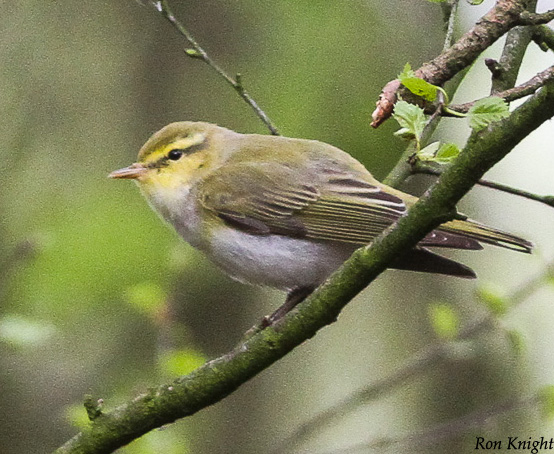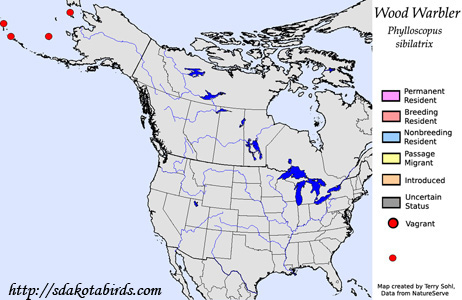| Length: 4.75 inches | Wingspan: 8.75 inches | Seasonality: Non-resident in South Dakota |
| ID Keys: Greenish upperparts, pale underparts, pale yellow breast, yellowish face and eyebrow | ||
 The
Wood Warbler is a "leaf warbler" species of the Old World. They are found as
breeding birds throughout much of temperature Europe, into far western Asia,
while they overwinter in tropical Africa. In North America they are
known from multiple sightings on islands and coastlines of Alaska.
The
Wood Warbler is a "leaf warbler" species of the Old World. They are found as
breeding birds throughout much of temperature Europe, into far western Asia,
while they overwinter in tropical Africa. In North America they are
known from multiple sightings on islands and coastlines of Alaska.
Habitat: Found in deciduous woodlands and forests
Diet: Feeds on insects and spiders. They will also sometimes feed on fruits and berries.
Behavior: Actively forages by hobbing and flitting through foliage, either in the forest canopy or closer to the ground. They feed by either gleaning insects directly from vegetation, or by capturing insects in short flights.
Nesting: The nest of a Wood Warbler is placed on the ground, or close to the ground in a shrub. It is a dome-shaped structure with a side entrance, built of grasses, moss, rootlets, leaves, and other vegetative material. The female lays between 5 and 7 eggs, and she alone incubates them. The eggs hatch after about 13 days, and both parents help to feed the young. Young fledge about 2 weeks after hatching.
Song: The song is a high-pitched trilling that continually increases in tempo. The trilling song is often followed by a lower-pitchd series of 4 or 5 soft, monotonous notes.
Migration: Strongly migratory, Wood Warblers breed in Europe and far western Asia, but move to tropical portions of Africa for the winter.
Interactive eBird map: Click here to access an interactive eBird map of Wood Warbler sightings
Similar Species: In their Old World range, may be confused with other Phylloscopus (leaf warbler) species. They are the largest of the Phylloscopus species seen in their normal range in Europe.
Conservation Status: Population trends appear to be declining in the European part of their range. However, overall they are still widespread and common in parts of their range. The IUCN lists the Wood Warbler as a species of "Least Concern".
Further Information: 1) BirdLife International - Wood Warbler
2) WhatBird - Wood Warbler
3) Royal Society for Birds - Wood Warbler
Photo Information: Photo by Ron Knight - May 11th, 2012 - Buchnan Country Park, Crawley, United Kingdom - Photo licensed under Creative Commons Attribution 2.0 Generic License
| Click below for a higher-resolution map |
 |
| South Dakota Status: Non-resident in South Dakota |
Additional Wood Warbler Photos (coming soon!!)
